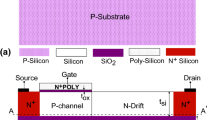Abstract
The conduction mechanism of quasi-breakdown (QB) for ultra-thin gate oxide has been studied in dual-gate CMOSFET with a 3.7 nm thick gate oxide. Systematic carrier separation experiments were conducted to investigate the evolutions of gate, source/drain, and substrate currents before and after gate oxide QB. Our experimental results clearly show that QB is due to the formation of a local physically-damaged-region (LPDR) at Si/SiO2 interface. At this region, the effective oxide thickness is reduced to the direct tunneling (DT) regime. The observed high gate leakage current is due to DT electron or hole currents through the region where the LPDR is generated. Under substrate injection stress condition, there is several orders of magnitude increase of Isub (Is/d) at the onset point of QB for n(p) - MOSFET, which mainly corresponds to valence electrons DT from the substrate to the gate. Consequently, cold holes are left in the substrate and measured as substrate current. Under gate injection stress condition, there is sudden drop and even change of sign of Isub (Is/d) at the onset point of QB for n(p)-MOSFET, which corresponds to the disappearance of impact ionization and the appearance of hole DT current from the substrate to the gate. In the LPDR region, the damaged structure may have two or multi metastable states corresponding to different effective oxide thickness. The thermal transition between two or multi metastable states leads to random telegraph switching noise (RTSN) fluctuation between two or multi levels.
Similar content being viewed by others
References
S. H. Lee, B. J. Cho, J. C. Kim and S. H. Choi, IEDM Tech. Dig., p. 605 (1994).
K. Okada, S. Kawasaki, and Y. Hirofuji, Ext. Abst. of 1994 lnt. Conf. Solid State Devices and Materials, p.565 (1994).
M. Depas, T. Nigam, and Marc M. Heyns, IEEE Trans. Electron Devices, 43, p. 1499 (1996).
Kenji Okada, Kenji Taniguchi, Appl. Phys. Lett., 70, p.351, (1997).
T. Yoshida, S. Miyazaki, and M. Hirose, Ext. Abst. of 1996 Int. Conf. Solid State Devices and Materials, p. 539 (1996).
T. Tomita, H. Utsunomiya, T. Sakura, Y. Kamakura, and K. Taniguchi, IEEE Trans. Electron Devices, 46, p.159 (1999).
F. Crupi, R. Degraeve, G. Groeseneken, T. Nigam, and H. E. Maes, IEEE Trans. Electron Devices., 45, p.2,329 (1998).
M. Houssa, T. Nigam, P. W. Mertens and M. M. Heyns, Appl. Phys. Lett., 73, p.514 (1998).
E. Miranda, J. Sune, R. Rodriguez, M. Nafris and X. Aymerich, Appl. Phys. Lett., 73, p.490 (1998).
A. S. Ginovker, V. A. Gristsenko and S. P. Sinitsa, Phys.Stat.Sol. (a), 26, p.489 (1974).
B. Eitan and K. Kolodny, Appl. Phys. Lett., 43, p.106 (1983).
L. D. Yao, F. T. Liou and S. Chen, IEEE Electron Device Lett., 4, p.261 (1983).
C. Chang, C. Hu and R. W. Brodersen, J. Appl. Phys., 57, p.302 (1985).
Y. Shi, T. P. Ma, S. Prasad and S. Dhanda, IEEE Trans. Electron Devices, 45, p.2355 (1998).
Acknowledgments
This work was supported by the Singapore NSTB Research Grant NSTB/17/2/3 and NUS University Research Project RP3982754.
Author information
Authors and Affiliations
Rights and permissions
About this article
Cite this article
Guan, H., He, Y.D., Li, M.F. et al. Investigation of Quasi-Breakdown Mechanism in Ultra-Thin Gate Oxides. MRS Online Proceedings Library 592, 131–136 (1999). https://doi.org/10.1557/PROC-592-111
Published:
Issue Date:
DOI: https://doi.org/10.1557/PROC-592-111




